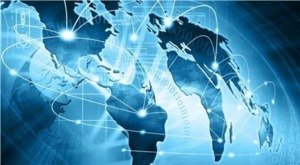
Dr Satyendra Naik speaks about how the global economy has shaped over the years and the transformation it has undergone in the midst of wars, depressions and pandemics.
 Overview
Overview
- Over a period of the last 90 years, the size, character, structure, functioning and dynamics of the global economy has undergone a dramatic transformation. While the post-war period was characterized by faster and widespread industrialization of the global economy supported by the Keynesian economic policy, it also witnessed the independence of the economies colonized in the pre-war period and their effort to pursue economic policies to develop their economies. This period of growth was punctuated by the oil crisis of 1974-79 which caused a new problem called stagflation. By the beginning of 1980s stagflation was overcome with the launch of a new economic philosophy of globalization. It brought about a massive global economic transformation through record investments by the developed countries into the less developed emerging market economies and record growth in world trade. The speed of globalization was halted by the financial crisis in 2008 which slid the global economy into the worst recession since 1930s. Policy reaction to the crisis was quick, unprecedented, novel and forceful. The rare combination of record Keynesian fiscal deficit and ultra-dovish unconventional monetary policy that revived the global economy by 2010. Although the fiscal deficit reverted to the normal level and Quantitative Easing by the Federal Reserve and other central banks reversed, the interest rates continued to be at near zero levels.
Great Depression 1930s
- The Great Depression of 1930s has been historically the worst economic crisis suffered by the global economy. Triggered by the great stock market crash in 1929 in America and compounded by the large negative wealth effect followed by the banking crisis caused by the chain of failures of banks that led to a massive demand contraction in the economy.Restrictive and beggar-thy-neighbor trade policies caught the nations in the vicious circle and intensified the problem. The doctrine of balanced budget, monetary system under gold standard and conventional central banking were an anachronism in the wake of this new economic calamity.
The Keynesian Revolution:
Saving the World from Economic Depression
- The global economy was in search of new policy framework guided by fresh perspective on the functioning and dynamics of an economy. At this juncture Cambridge economist, John Maynard Keynes emerged as the messiah to save the capitalistic economies by his novel General Theory contrasting the earlier classical economics. The central doctrine of the General Theory was that the momentum of an economy is guided by the size and growth of the aggregate demand in the economy comprising the private consumption and investment demand,and net government expenditure.Policy prescription that followed from this was that during deep economic depression when private consumption and investment demand fails to respond to monetary policy of low interest rate, the government has to pump and prime the economy through massive expenditure through deficit financing by abandoning the doctrine of balanced budget. After its first prescription in 1930s, deficit financing became a standard cure for depression and recessions.
Roaring Industrial Growth of 1950s-60s
- The 1950s and 60s marked the era of unprecedented roaring economic growth in global economic history fueled by cheap energy source and supply, the crude oil, supported by fiscal deficits and cheap money policies. This phase of sustained industrial growth was abruptly interrupted by the action of oil exporting nations to form a cartel, Organization of Petroleum Exporting Countries (OPEC), and raising the crude oil price from $3 per barrel to $12 in 1974 and to $39 in 1979. The global economy went into a tailspin under the impact of this oil crisis and experienced the first major global economic recession since the Great Depression of 1930.
Oil Crisis of 1970s
- Oil crisis gave rise to a new economic problem called stagflation. Thirteenfold rise in crude oil prices raised the cost structure in all economies resulting in cost-push inflation, while at the same time sliding the aggregate demand in all oil importing nations and blowing the winds of recessionary pressure in their economies. The economic crisis of second half of 1970s could not be resolved by the traditional monetary and fiscal policies, and demanded a structural reform in the functioning of the global economy.
Enter the Globalization 1980s
- The philosophy of globalization was born out of this quagmire.It was imperative to have a new policy and action in three areas of the economy. Lesser government involvement and intervention with economic liberalization, removal of government regulations, and privatization of government enterprises to allow free market mechanism to function efficiently in the economy. Removal of tariff and other restrictions on foreign trade and investment for promoting free global trade and investments. Ensuring adequate financing mechanism to support higher global trade and investments.
Smith-Ricardo-Keynes (SRK) Combo
- Theoretical underpinning of policy of globalization was derived from the ideas and theories of three great economists. Adam Smith, for advocacy of free markets, removal of government regulations in business and minimal government. David Ricardo, for promotion of free trade based his principle of comparative cost advantage. And John Maynard Keynes’ theory of deficit financing in international context for creating a financing channel for higher global trade and investments with US dollar and US Treasury bills playing a predominant role.Globalization was Smith-Ricardo-Keynes (SRK) theories in combo.
3W Policy
- It is also known as the 3W (Washington-World Bank-Wall Street) policy for the initiative these institutions and agencies took to formulate and implement the policy of globalization. In the early 1980s Ronald Reagan in America and Margaret Thatcher in Britain took the lead in pursing these policies that were supported by the World Bank and investment bankers in the Wall Street.The globalization channeled massive dollar investments from the developed world into the emerging market economies, and later promoted exports from the latter economies to the former thereby raising the rates of economic growth in both the economies. The US Treasury bills constituted the primary source of funding globalization.
Global Financial Crisis 2008*
- The global economy witnessed the worst economic disaster since the Great Depression with the break out of the financial crisis in 2008. Triggered in America due to the sub-prime debt repayment defaults leading to the collapse of a trillion dollar + market for sub-prime mortgage securities, it inflicted heavy financial casualties and huge losses due to its sheer large size on the mortgage and commercial banks, and financial institutions. The losses due to defaults of borrowers were also compounded by the losses also in derivatives positions in several novel instruments like credit default swaps in the market by banks, financial institutions and insurance companies. It also affected the global banking system due to its involvement in the market as well as the chain reaction from the cross lending. The crash in the stock market, and fall in consumer spending and business investment globally caused an unusual largest fall in global GDP for the first time since 1930s.
Age of Ultra-Monetarism: Era of Cheap Money
- Policy reaction to the financial crisis marked a new era in monetary policy. Unconventional approach to monetary policy with Quantitative Easing (QE, involving the Federal Reserve buying the Govt. and other securities in the market to inject liquidity in the financial system) and near zero interest rates making borrowing cheaper was intended to promote borrowing for consumption and investment spending and thereby recycle the growth momentum at a higher pace. Both these measures helped in reviving the economy. Although QEs are reversed the sub-zero interest have become a new normal in monetary situation across the developed world.
US-China Trade War
- For years since the beginning of globalization China followed the trade practices in violation of fair trade, trademarks, and intellectual property rights, without abiding by the principle of reciprocity. In 2018 President Trump took a stern action against imports from China by imposing tariffs and non-tariff barriers and forcing China to extend fair treatment to imports from the US. This prolonged trade war has led to ongoing trade negotiations that are yet to see any significant tangible results.
Economic Repercussions of Corona
- The most bizarre, unexpected and challenging problem which hit the global population and economy has been Covid-19. Since March the virus has spread from country to country across the globe on a scale unprecedented and unimaginable level to be beyond the control of WHO as well as medically most advanced nations. It has brought a devastating impact on the global economy which has been set behind in economic terms by at least a year, with some irrecuperable losses. Although nations are fighting on medical grounds and setting social behavior norms, the normalcy will only return when the vaccine is found and Covid-19 is eradicated like small pox, polio. Restoration of local, regional and cross-country mobility of people and goods will only reestablish normalcy in economic activities, employment and growth.
*Refer Author’s Book ‘The Global Financial Crisis: Genesis, Policy Response and Road Ahead, Springer.
The writer runs Spectrafin. He has more than 30 years’ experience in finance and banking. Email: nsatyen@gmail.com





